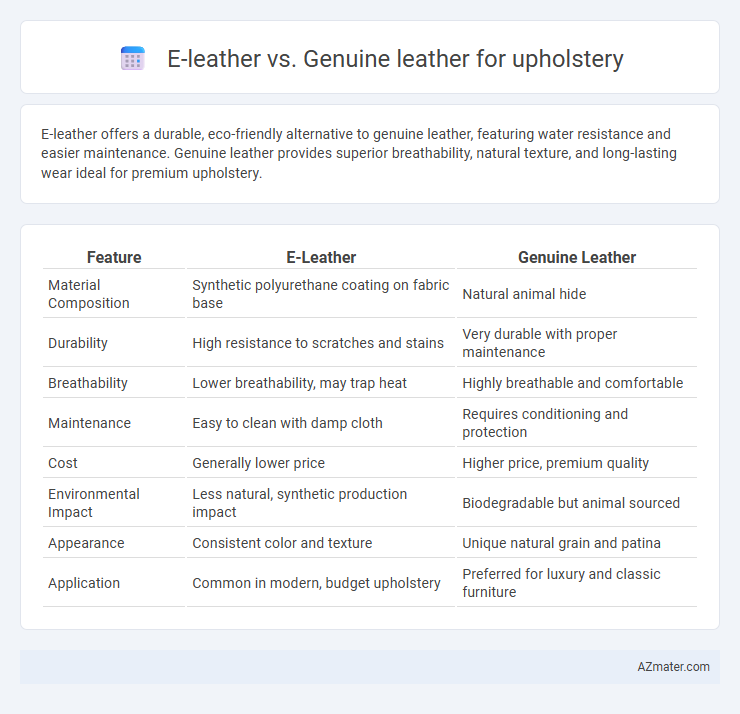E-leather offers a durable, eco-friendly alternative to genuine leather, featuring water resistance and easier maintenance. Genuine leather provides superior breathability, natural texture, and long-lasting wear ideal for premium upholstery.
Table of Comparison
| Feature | E-Leather | Genuine Leather |
|---|---|---|
| Material Composition | Synthetic polyurethane coating on fabric base | Natural animal hide |
| Durability | High resistance to scratches and stains | Very durable with proper maintenance |
| Breathability | Lower breathability, may trap heat | Highly breathable and comfortable |
| Maintenance | Easy to clean with damp cloth | Requires conditioning and protection |
| Cost | Generally lower price | Higher price, premium quality |
| Environmental Impact | Less natural, synthetic production impact | Biodegradable but animal sourced |
| Appearance | Consistent color and texture | Unique natural grain and patina |
| Application | Common in modern, budget upholstery | Preferred for luxury and classic furniture |
Introduction to Upholstery Materials
E-leather, a synthetic material made from polyurethane and fabric backing, offers durability and easy maintenance, making it a popular choice for modern upholstery. Genuine leather, derived from animal hides, is prized for its natural texture, breathability, and long-lasting quality, though it requires more care and can be costlier. Understanding the properties of both materials helps in selecting the best option for upholstery based on durability, aesthetics, and budget.
What is E-Leather?
E-leather, or engineered leather, is a composite material made by combining natural leather fibers with synthetic polyurethane, designed to enhance durability and reduce environmental impact compared to genuine leather. This material offers the look and feel of real leather while providing greater resistance to wear, stains, and fading, making it ideal for upholstery in high-traffic areas. E-leather is also more cost-effective and easier to maintain than genuine leather, appealing to both residential and commercial furniture markets.
Understanding Genuine Leather
Genuine leather, made from the animal's hide, offers natural durability, unique grain patterns, and breathability that enhances comfort in upholstery applications. This material develops a patina over time, improving its aesthetic appeal and increasing the value of furniture pieces. Compared to E-leather, genuine leather demands specific maintenance to prevent drying and cracking but provides superior longevity and authenticity.
Production Processes Compared
E-leather production involves coating fabric or synthetic bases with polyurethane, resulting in a consistent texture and enhanced durability through a less resource-intensive manufacturing process compared to genuine leather. Genuine leather requires the tanning of animal hides using complex chemical or vegetable treatments, which is labor-intensive and environmentally impactful due to water usage and waste generation. The synthetic nature of E-leather allows for scalable production with fewer emissions, while genuine leather's natural origin ensures breathability and aging quality but demands more extensive resource consumption.
Durability and Longevity
E-leather, made from polyurethane-coated fabrics, offers high resistance to scratches, stains, and fading, making it a durable choice for upholstery with easy maintenance. Genuine leather, derived from animal hides, provides exceptional longevity by developing a unique patina over time but requires regular care to prevent cracking and wear. While genuine leather typically lasts longer under proper maintenance, e-leather delivers consistent durability and resists moisture and temperature fluctuations better.
Environmental Impact and Sustainability
E-leather, often made from polyurethane or other synthetic materials, typically has a lower environmental impact during production due to reduced water usage and absence of animal farming emissions compared to genuine leather. Genuine leather, derived from animal hides, involves significant resource consumption and greenhouse gas emissions but is biodegradable and durable, potentially reducing long-term waste. Sustainable upholstery choices weigh the synthetic material's carbon footprint against genuine leather's natural origin and lifecycle, emphasizing the importance of recycling and material sourcing in minimizing ecological footprints.
Comfort and Aesthetics
E-leather offers consistent texture and color, providing a modern aesthetic with easy maintenance, while genuine leather delivers superior breathability and natural variations that enhance comfort and luxury. The softness of genuine leather improves over time, molding to body contours, whereas e-leather maintains a uniform feel but can be less breathable and prone to heat retention. Both materials suit upholstery needs, with genuine leather favored for timeless elegance and comfort, and e-leather chosen for durability and affordable style.
Cost Differences
E-leather for upholstery typically costs 30-50% less than genuine leather, making it an affordable alternative for budget-conscious buyers. Genuine leather involves higher production expenses due to animal sourcing, tanning, and finishing processes, contributing to its premium price. While E-leather offers cost savings, genuine leather is often preferred for its durability and natural texture.
Maintenance and Care Requirements
E-leather requires minimal maintenance, needing only regular wiping with a damp cloth and occasional application of a conditioner to prevent cracking. Genuine leather demands more intensive care, including periodic cleaning with specific leather cleaners and conditioning treatments to maintain suppleness and avoid drying or staining. Both materials benefit from protection against direct sunlight and spills to prolong their lifespan and appearance.
Choosing the Right Material for Upholstery
Choosing the right material for upholstery involves comparing e-leather and genuine leather based on durability, maintenance, and aesthetic appeal. E-leather offers a cost-effective, eco-friendly alternative with consistent texture and easy cleaning, while genuine leather provides unmatched natural breathability, aging elegance, and increased longevity. Consider factors such as room usage, budget, and desired look to select the ideal upholstery material that balances comfort and style.

Infographic: E-leather vs Genuine leather for Upholstery
 azmater.com
azmater.com